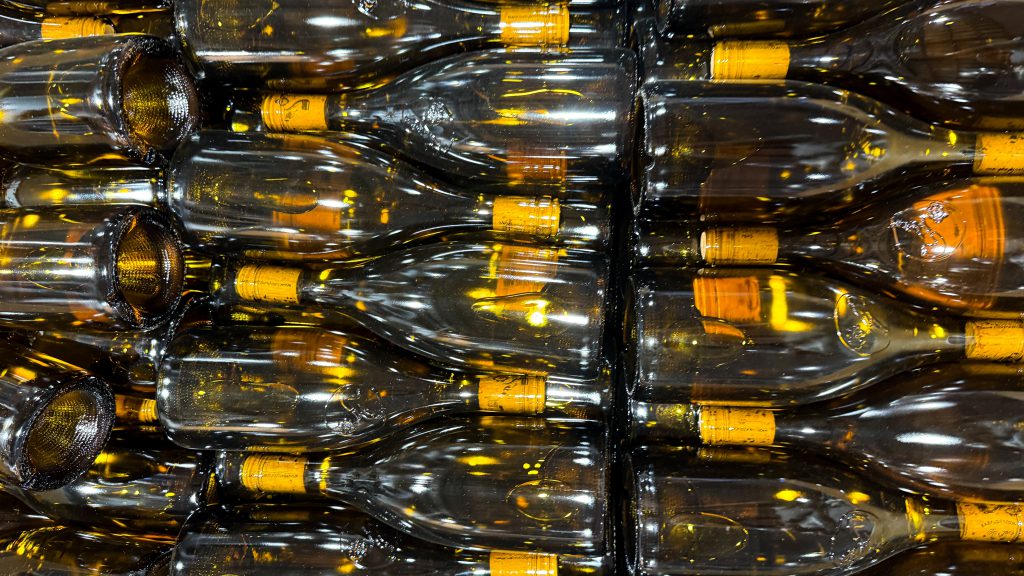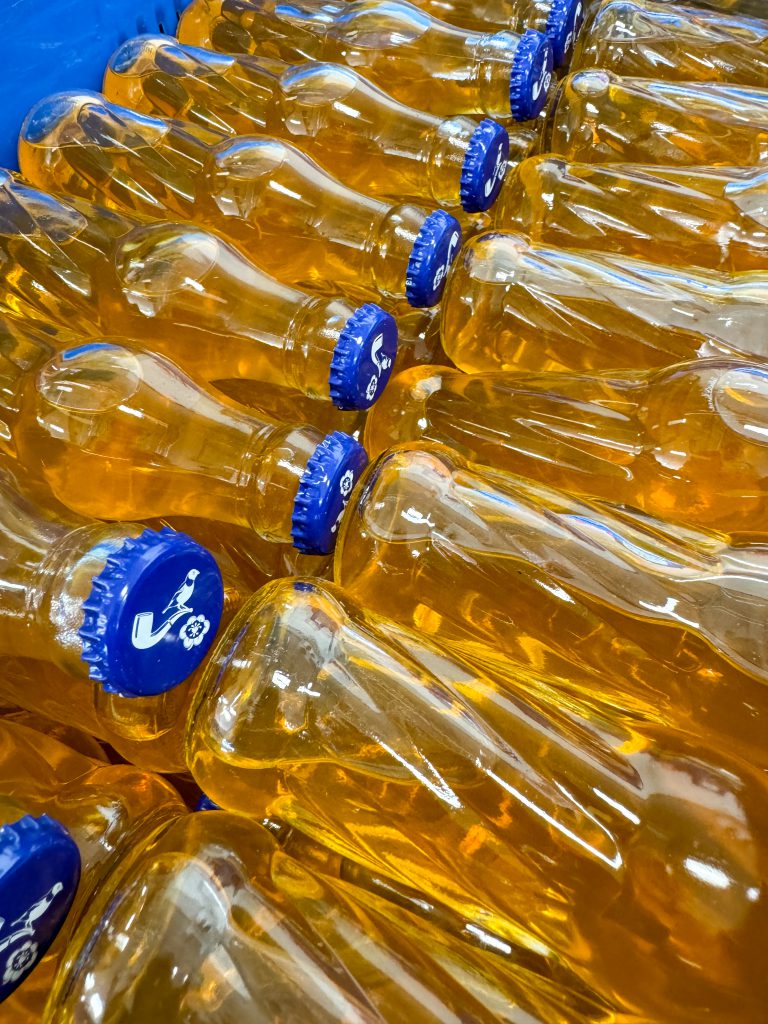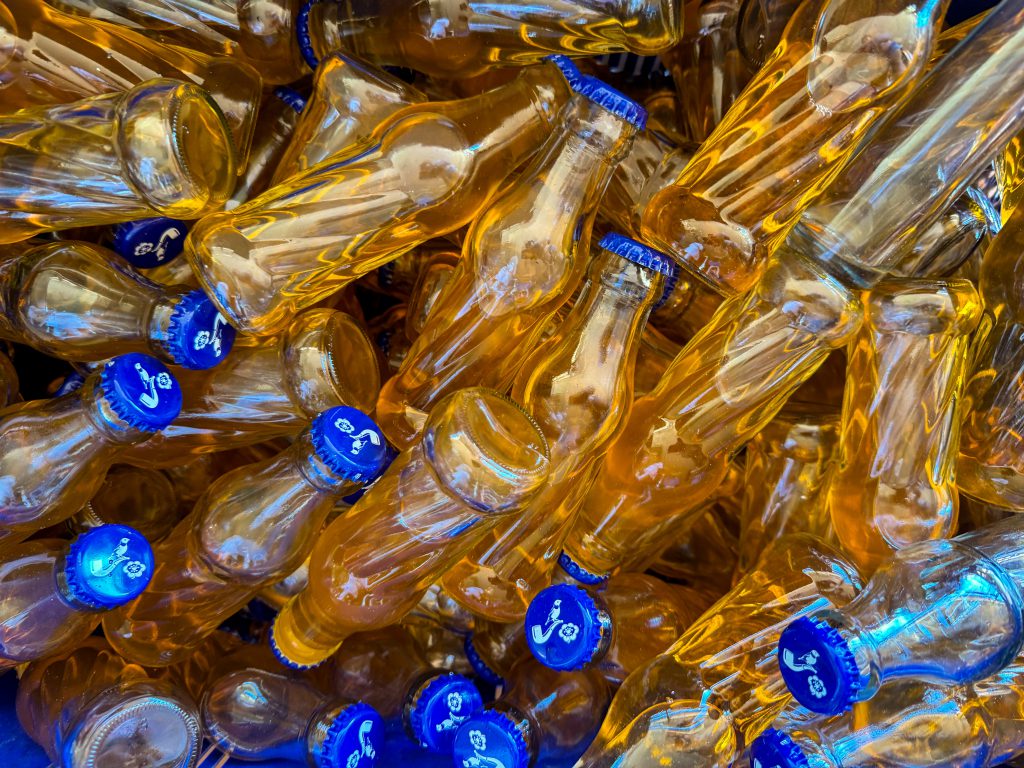
Restaurants
Spa
Day Visits
Shop
Functions
16°C
February 26th, 2024
Insights from our sustainability journey
You would be excused for thinking of Babylonstoren as a garden surrounded by a farm. Our beautiful fruit and vegetable garden was and always will be the heart of the operation. But we also make a point of describing ourselves as “a working farm.” A look at our glass consumption and management brings the operational side of Babylonstoren into perspective.

Like any highly active hive, the farm relies on an army of worker bees to produce outstanding produce and experiences for guests who visit our garden, shops, spa, hotel, tasting room, restaurants, and guest accommodation. It amounts to a substantial number of people who must stay hydrated on any given day.
Babylonstoren’s water bottling plant fills glass bottles with pure farm water to be consumed by guests and employees alike. Our award-winning wines are bottled in a variety of glass bottles, and we produce a range of preserves and deli products in glass vessels. Not to mention the charming vintage-style bottles used for our refreshing bitterlekker aperitif.


In total, this amounts to a mountain of glass that cycles through the farm continually. As of 2021, a sizeable chunk of this glass mountain is sterilised and reused on the farm – with some water bottles going through the cycle up to 100 times. This has a considerable impact on our demand for new glass. A monthly average of 4.47 tonnes of glass that cannot be reused is recycled off-site by a recycling plant.
Facing up to the carbon footprint of a thriving enterprise is daunting. It reminds of the saying: “How do you eat an elephant? One bite at a time.”
It starts with a commitment to change – however small at first, or perhaps it remains small forever but with frequent repetition the cumulative effect can deliver surprising results. The next step is to implement sensible systems.
Glass recycling on a wine farm can be unpleasant and dangerous work. Haphazardly discarded bottles break, producing sharp shards and edges, and the bouquet that develops when wine residue is left to ferment in the hot sun is quite unappealing. To streamline the collection process, this first, crucial step was made safer and more pleasant by inserting dividers into the collection bins.
“Our maintenance team reused the plastic divider boards from our bottle pallets to create dividers for the bins. Bottles are now stacked upright and upside down, so there are no broken bottles, and it helps that the last bit of wine is drained off in the process,” says Marina Coetzee, Bottling & Logistics Manager at the Babylonstoren cellar.
Wine and water bottles are treated separately on the farm. “The cellar and water bottling teams have different systems, as the bottles differ greatly and require different machine parts to clean,” she says. Collection points are dotted around the farm, wherever glass bottles are used for pouring. “We have wooden bins at the Greenhouse, Babel Restaurant and Tasting Room that are emptied three times a week on average,” says Marina.
This adds another layer of administration to the production process, as wines consumed on-site are bottled separately in reused bottles, while wines to be consumed off-site are bottled in new glass. “We’ve created a closed system for this,” Marina explains. “When we bottle a vintage, we start by bottling the sterilised reused bottles to be poured on the farm, and supplement with new glass for off-site consumption.”
“All our bottles are reused except for the Mourvèdre Rosé, as the vintage is sandblasted on the bottle. With the other wines the sandblasted label in front stays the same from vintage to vintage. We must only remove the plastic back label and replace it with one that has the correct vintage information. Bottles are first washed, then capsules and labels are removed, followed by an anti-bacterial rinse and a second internal rinse to clean the bottles,” she says.
The team uses a chat group to communicate when collection bins need emptying. “The system works well. It is a massive improvement to no longer deal with broken glass, and that the bottles run dry before we collect them,” says Marina.
Marina is one of two glass gurus on the farm. The other is Ernst Kleynhans, Food Production Operations Manager, who handles the packaging of special lines like the bitterlekker aperitif.

“For starters, we buy only local glass from a South African supplier, which gets our CO2 footprint facing the right direction,” says Ernst. “Glass is great as it is 100% infinitely recyclable. The material’s molecular structure is not altered during the recycling process, which makes it perfectly suited to a circular economy.”
“We use a laser printer to imprint the Best Before date on the bottle, so technically it cannot be reused for export purposes. We pour a lot of bitterlekker for promotion purposes on the farm, at stalls and activations, and for these occasions we use reused bottles. Bear in mind that the new glass we buy is also not 100% virgin material, as it will contain a percentage of recycled glass. Glass is the most recyclable packaging material on earth.”

It does not stop with glass. A bitterlekker six-pack is ensconced in a cardboard sleeve for easy handling. “This is double layer, so it’s quite intensive packaging,” Ernst says of the sleeve. “We’re switching to new packaging soon which will have only one component, so it’s less material intensive, which means less cardboard and fewer trees felled.”
Bite by bite, the elephant gets smaller.